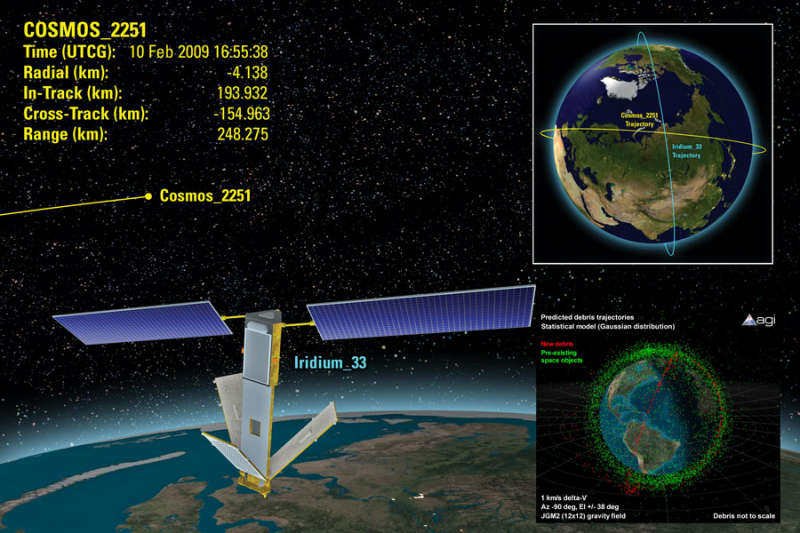Credit & Copyright: Analytical Graphics, Inc.
Explanation:
How often do satellites collide?
Although minuscule space debris may strike any satellite on occasion, the first known
collision between time two full satellites
occurred only last week.
Even though thousands of
satellites have been launched,
the low collision rate is caused by the great vastness of space.
Last week, however, a defunct Russian communications satellite named
Cosmos 2251 smashed right
into an operational US communications satellite named
Iridium 33 over
Siberia,
Russia.
Both satellites were destroyed.
The sheer number of massive particles in a
dispersing debris cloud,
depicted in an inset
image above, increases the risk that other operating satellites might be struck
by a harmful fast-moving projectile.
The collision occurred in
low Earth orbit only 750 kilometers up, a height shared by many
satellites but significantly higher than the 350-km high human-occupied
International Space Station.
Since satellites may disintegrate when struck by fast-moving
space junk, the crash focuses concern that a future
dramatic satellite collision may one day start an
ablation cascade
of increasingly more collisions.
The result
could then render future human space flights increasingly risky and expensive satellite
lifetimes increasingly short.
1999 2000 2001 2002 2003 2004 2005 2006 2007 2008 2009 2010 2011 2012 2013 2014 2015 2016 2017 2018 2019 2020 2021 2022 2023 2024 2025 |
Yanvar' Fevral' Mart Aprel' Mai Iyun' Iyul' Avgust Sentyabr' Oktyabr' Noyabr' Dekabr' |
NASA Web Site Statements, Warnings, and Disclaimers
NASA Official: Jay Norris. Specific rights apply.
A service of: LHEA at NASA / GSFC
& Michigan Tech. U.
|
Publikacii s klyuchevymi slovami:
satellite - ISZ - Sputniki iskusstvennye - stolknoveniya
Publikacii so slovami: satellite - ISZ - Sputniki iskusstvennye - stolknoveniya | |
Sm. takzhe:
Vse publikacii na tu zhe temu >> | |
